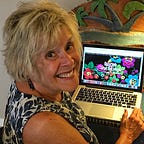I have just finished reading “These Precious Days”, an essay written by Ann Patchett published in Harper’s Magazine. I loved it so much the first time; I re-read it for a second. I feel ridiculously close to Ann after reading this candid, vulnerable story about her relationship with a newish friend named Sooki. Sooki Raphael is Tom Hank’s assistant and friend. He describes her as “someone who is all that is good in the world.” A neighbor of the Patchett’s described Sooki as a saint. No doubt if Tom Hanks and Ann Patchett believe their friend to possess such wonderful qualities, she probably is a saint. But I think Ann is the saint in the story.
The initial relationship begins at an event in Washington, D.C. to promote Hank’s book, Uncommon Type. The Sooki and Ann relationship evolves through their sporadic email correspondence.
“The world that Sooki inhabited was electrified by greens and blues, purple bougainvillea draping over hot-pink walls, colors too vivid to be explained. She would pour color into my inbox for a while and then be gone again.”
A pancreatic cancer diagnosis and a clinical trial in Nashville matching her form of cancer, brought the two women together in physical proximity. Ann “The world that Sooki inhabited was electrified by greens and blues, purple bougainvillea draping over hot-pink walls, colors too vivid to be explained. She would pour color into my inbox for a while and then be gone again.” Sooki, someone she has only met twice, to live in her downstairs’ apartment while undergoing treatment. Ann excuses away the offer saying, “It’s a southern thing to invite people into your home.”
I guess I’m pretty selfish. My nest (home, hotel room, pop-up tent) is my sanctuary. Being a basic introvert, it’s my place to rest and recoup. It causes me anxiety to share my sacred space with people other than family. Ann Patchett also refers to herself as an introvert. Nevertheless, she welcomes people into her home and does so with such graciousness. There were no conditions or expectations put on Sooki’s stay. Ann made her physical environment exquisitely comfortable. Sooki made it easier by being the consummate guest. The onset of the pandemic occurred during Sooki’s stay. She could not fly home to California in her compromised state. They were pandemic partners sharing space, time, and a cancer journey.
This glimpse into the lives of these extraordinary women provides such insight into the creative process. Ann wrote; Sooki painted. As someone who aspires to do both, I was transformed by their insights.
Ann noted about her writing:
“When I’m putting together a novel, I leave all the doors and windows open so the characters can come in and just as easily leave. I don’t take notes. Once I start writing things down, I feel like I’m nailing the story in place. When I rely on my faulty memory, the pieces are free to move. The main character I was certain of starts to drift, and someone I’d barely noticed moves in to fill the space. The road forks and forks again. It becomes a path into the woods. It becomes the woods. I find a stream and follow it; the stream dries up, and I’m left to look for moss on the sides of trees.”
I’ve yet to write fiction but I too take a circuitous route when writing a story. I often begin an essay or blog post with one story in mind and end up landing elsewhere as it progresses (not that I’m comparing my writing to Ann Patchett’s.)
“Sooki always wanted to paint. But she had other jobs.” During her tenure in the Patchett house, Sooki started to paint like someone who had never stopped.
“Her true work, which had lingered for so many years in her imagination, emerged fully formed, because even if she hadn’t been painting, she saw the world as a painter, not in terms of language and story but of color and shape. She painted as fast as she could get her canvases prepped, berating herself for falling asleep in the afternoons.
Sooki didn’t talk about her husband or her children or her friends or her employer; she talked about color. We talked about art. She brought her paintings upstairs to show us: a person who was too shy to say good night most nights was happy for us to see her work. There was no hesitation on the canvases, no timidity. She had transferred her life into brushwork, impossible colors overlapping, the composition precariously and perfectly balanced. The paintings were bold, confident, at ease. When she gave us the painting she had done of Sparky on the back of the couch, I felt as if Matisse had painted our dog.”
The love these friends shared. They participated in a yoga practice for an hour each morning and evening. Ann even tried doing psilocybin (mushrooms) with Sooki during her cancer journey. It worked out for Sooki, but Ann did not fare as well on that particular journey (She described the trip as eight hours of hard labor). She was willing to share everything with her friend.
“Pay attention, I told myself. Pay attention every minute.” This was her mantra during the first months of the pandemic and Sooki’s stay. What was and is a disastrous time became a cherished opportunity. I suspect that is the meaning of life.
“As it turned out, Sooki and I needed the same thing: to find someone who could see us as our best and most complete selves. Astonishing to come across such a friendship at this point in life. At any point in life.”
Don’t we all aspire to achieve such a friendship. To find someone who is able to see us as our best and most complete selves.
